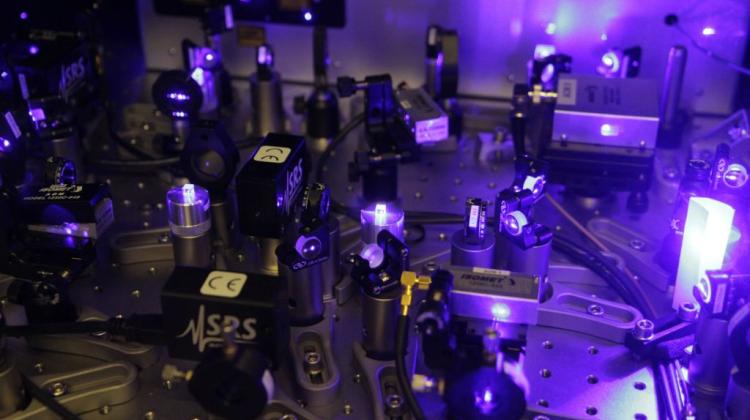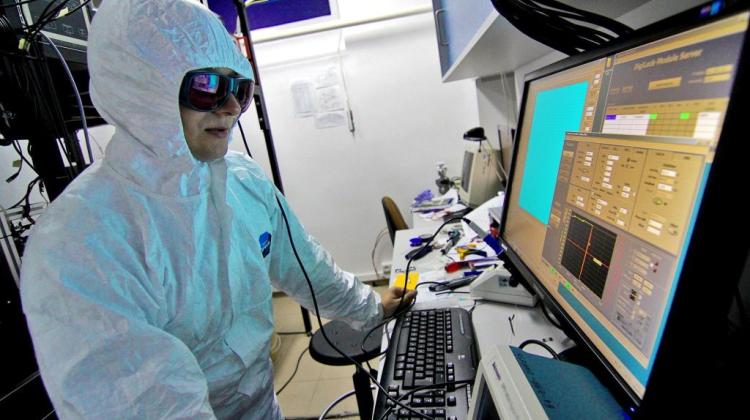Poland's first optical clock in Toruń
 Photo: Anna Bielawiec-Osińska
Photo: Anna Bielawiec-Osińska
Poland\'s first optical atomic clock has been built at the Institute of Physics, Nicolaus Copernicus University in Toruń. The clock that will be one second late in about 31 million years, is an ultra-accurate frequency standard, which can be used to synchronize the most accurate clocks.
Work on the construction of the clock began in 2008 and was carried in the project "Polish Optical Atomic Clock" led by Prof. Czesław Radzewicz from the University of Warsaw and financed by the Ministry of Science and Higher Education.
Three Polish research centers contributed to the creation of the clock. Prof. Wojciech Gawlik’s team at the Jagiellonian University in Kraków developed the first atomic model using ultracold strontium atoms, researchers at the University of Warsaw built an optical frequency comb. Nicolaus Copernicus University in Toruń built the second atomic model and ultra-stable laser. In November last year, at the National Laboratory FAMO all components were assembled building not one, but two optical clocks, which allowed to verify their proper operation.
Optical atomic clock is a combination of electronics, computers, vacuum equipment, lasers and hundreds of optical components. According to Polish physicists, only a few research centres worldwide have optical clocks similar to the one in Toruń. They are in the United States, Japan, Germany and France.
"We now have an ultra-accurate frequency standard, which can be used to synchronize the most accurate clocks. This is a breakthrough in metrology. Accuracy of this clock is 10 -15 seconds, achieved after 10 minutes. That means that the clock will be only about one second late after about 31 million years. This is an unimaginable accuracy" - said director of the National Laboratory for Atomic, Molecular and Optical Physics in Toruń, Dr. Roman Ciuryło.
Optical atomic clocks - emphasize the experts - are a breakthrough in metrology. Potentially they can be used in geodesy, for example in accurate mapping of the Earth\'s gravitational potential, for the exploration of mineral, oil and groundwater deposits. Other future applications may include improved satellite navigation systems, like GPS, and improved the operation of telecommunications networks.
This highly accurate clock can also be used for precision measurements. "More and more physical units, such as meter, are based on frequency measurement. The more accurately metrologists are able to define a second, more accurately other units can be defined" - said Dr. Michał Zawada, Faculty of Physics, Astronomy and Applied Computer Science, Nicolaus Copernicus University in Toruń.
He explained that researchers can use the Toruń optical clock to synchronize their accurate research devices such as spectrometers. "They can also use them to check, for example, whether physical constants are really constant, carry out astrophysical observations, study dark matter and test the theory of relativity. Also possible is a change of the 1967 definition of a second, which is currently based on cesium atoms in ordinary atomic clocks" - described Dr. Michał Zawada.
What is so unique about optical atomic clocks? "They use the optical vibrations that are 40 thousand times faster than conventional vibrations used in atomic clocks. That is the factor by which their accuracy increases" - explained Dr. Roman Ciuryło.
PAP - Science and Scholarship in Poland
ekr/ krf/ mrt/
tr. RL
Przed dodaniem komentarza prosimy o zapoznanie z Regulaminem forum serwisu Nauka w Polsce.

















